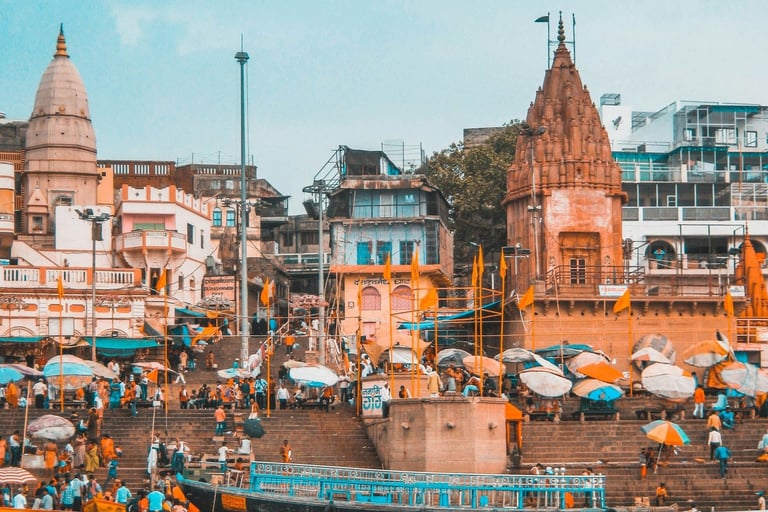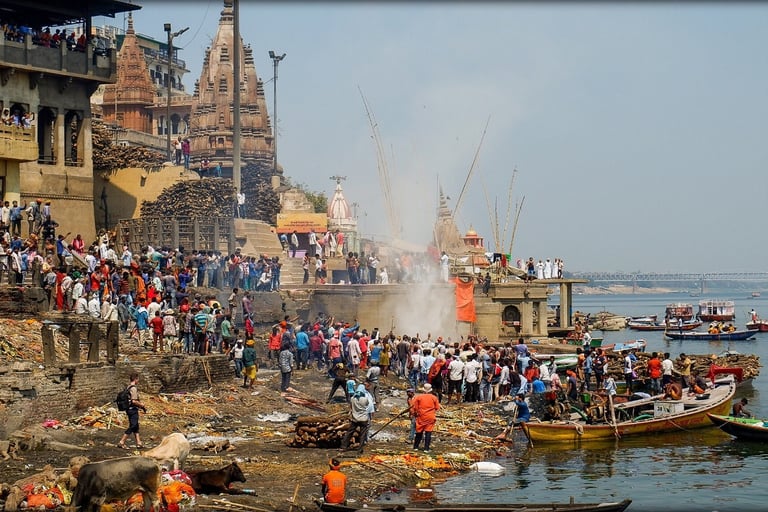
3 Unique Ghats of Varanasi-
"A visit to these three ghats is the essence of the entire philosophy of Kashi – where there is a celebration of life at Dashashwamedh, flow of peace and knowledge at Assi, and the ultimate truth of salvation at Manikarnika!"
varanasioneheels
11/3/20255 min read


Varanasi, also known as Kashi, is the world's oldest living city. Its ghats are the soul of this city—where devotion resonates in every wave, faith in every lamp, and the call for salvation in every voice.


Dashashwamedh Ghat – The Heart of Varanasi and a Symbol of Faith
Dashashwamedh Ghat is one of Varanasi's most prominent and ancient ghats, located on the banks of the River Ganges near the Kashi Vishwanath Temple. It is said that Lord Brahma performed ten (ten) Ashwamedha Yagyas (sacrifices) here to welcome Lord Shiva, hence the name "Dashashwamedh." This ghat is considered the center of Varanasi's religious, cultural, and spiritual identity.
When the first rays of the morning sun fall on the Ganges, the view from Dashashwamedh Ghat is breathtaking. Sadhus and saints bathe in the Ganges, the echo of mantras fills the air, and devotees are seen immersed in aarti and meditation. This ghat offers a true "Subah-e-Banaras" experience—filled with peace, tranquility, and positive energy.
The Ganga Aarti held here in the evening is world-famous. When the flames of hundreds of lamps burn simultaneously and the priests perform aarti to the sound of bells, the atmosphere is filled with divinity. Tourists from far and wide capture this moment not on camera, but in their hearts.
After returning from Dashashwamedh Ghat, everyone is left with the same feeling—as if they have had a direct encounter with God. The cool breeze of the Ganges, the glow of the lamps, and the atmosphere of devotion create an experience that lasts a lifetime. This is the place where faith and peace flow together.
The timings for the world-famous evening Ganga Aarti at Dashashwamedh Ghat vary depending on the season, as the ceremony typically begins right after sunset.
Here are the general timings according to the weather/season:
Season Evening Aarti Time:
Summer (April to September)
Usually starts between 6:45 PM and 7:00 PM.
Winter (October to March)
Usually starts between 5:45 PM and 6:00 PM.
Monsoon (July to September)
Similar to summer timings (around 6:45 PM).
Assi Ghat – A Confluence of Vibrancy and Peace of Banaras


Assi Ghat – A Confluence of the Vibrancy and Peace of Banaras
Assi Ghat is located at the southern edge of Varanasi, where the Assi River and the Ganges River meet. It is said that Goddess Annapurna Devi buried her sword, named Assi, here, hence the name "Assi Ghat." This ghat is one of Varanasi's most vibrant, colorful, and culturally rich places.
Mornings are the most spectacular here. Sunrise marks the beginning of "Subah-e-Banaras"—a festival where people begin their day with yoga, music, and meditation. Sitting on the banks of the Ganges, watching the sunrise, listening to the chirping of birds, and immersing themselves in the sound of mantras fills the soul with peace.
In the evening, the Ganga Aarti is a sight to behold—the light of lamps, chanting of mantras, and the ringing of bells fill the atmosphere with spiritual energy.
The cafes, tea shops, and local markets surrounding Assi Ghat are a highlight, where tourists enjoy local cuisine and Banarasi culture. Additionally, a boat ride overlooking the Ganges is an unforgettable experience for every visitor.
Visitors say that Assi Ghat possesses a unique magic—a place where devotion, music, peace, and the fragrance of life flow together. The atmosphere here is heart-warming and makes every visitor realize that Banaras is not just a place, but a feeling.
The Aarti lasts for approximately 45 minutes to 1 hour.
To secure a good viewing spot, you should aim to reach the Ghat at least 45 minutes to 1 hour before the scheduled start time.
During times of flood (especially during peak monsoon), the Aarti location may be shifted from the river bank to the roof or an elevated platform, but the time generally remains the same.
It's always a good idea to confirm the exact time with a local source or your hotel on the day of your visit.
Dashashwamedh Ghat – The Heart of Varanasi and a Symbol of Faith
Manikarnika Ghat – The Land of Moksha and Symbol of Peace of Soul


Manikarnika Ghat is one of Varanasi's most ancient and sacred ghats, located in the middle of the Ganges River. It is believed that Goddess Parvati's gem (earring) fell here, giving the ghat its name "Manikarnika." According to mythological belief, Lord Vishnu granted Shiva the boon of salvation here, hence the name "Moksha Bhoomi."
In the morning, a unique sense of peace is experienced here. The flowing waters along the Ganges and the chanting of the sages fill the atmosphere with spiritual energy. Although cremations (funerals) take place here, the scene evokes not fear, but a sense of the truth of life and the liberation of the soul.
People from various parts of India bring the mortal remains of their loved ones here, as it is believed that cremation at Manikarnika Ghat grants salvation to the soul.
Foreign and domestic tourists often remark that Manikarnika Ghat is "the bridge between life and death." Sitting here and meditating, watching the flow of the Ganges, or taking a boat ride to view this ghat is a profound experience.
The small cafes and local shops nearby offer a simple yet relaxing atmosphere. The Ganga Aarti, the lives of the sadhus, and the pervasive faith make one feel that even death in Varanasi is a celebration of life.
Coming to Manikarnika Ghat, one feels that this is not the end, but a new beginning in the soul's journey.
Manikarnika Ghat (Key Points)
Gateway to Salvation (Moksha): Considered the holiest cremation ground in Hinduism. It is believed that being cremated here grants instant Moksha (liberation from the cycle of rebirth).
Eternal Flame: The funeral pyre fire has been burning continuously for centuries, symbolizing the eternal nature of the life cycle.
Mythological Name: Named after the Sanskrit words 'Mani' (Jewel) and 'Karnika' (Earring), linked to a legend where Lord Shiva's or Goddess Sati's ear ornament fell here.
Dom Raja: The cremation rituals are overseen by the Dom community, whose chief, the 'Dom Raja,' holds a generational and sacred authority here.
Profound Philosophy: It offers a stark, profound viewing of the transience of life and the undeniable truth of death.
"Ready to explore the spiritual beauty of Varanasi?
Click below to get your personalized quote now!"
Call/WhatsApp- 7800664900
Book Your Trip Now!
Varanasi On Wheels
Book your unforgettable journey with us today!
Support


Subsidry of world view travel varanasi
© 2025. All rights reserved.
